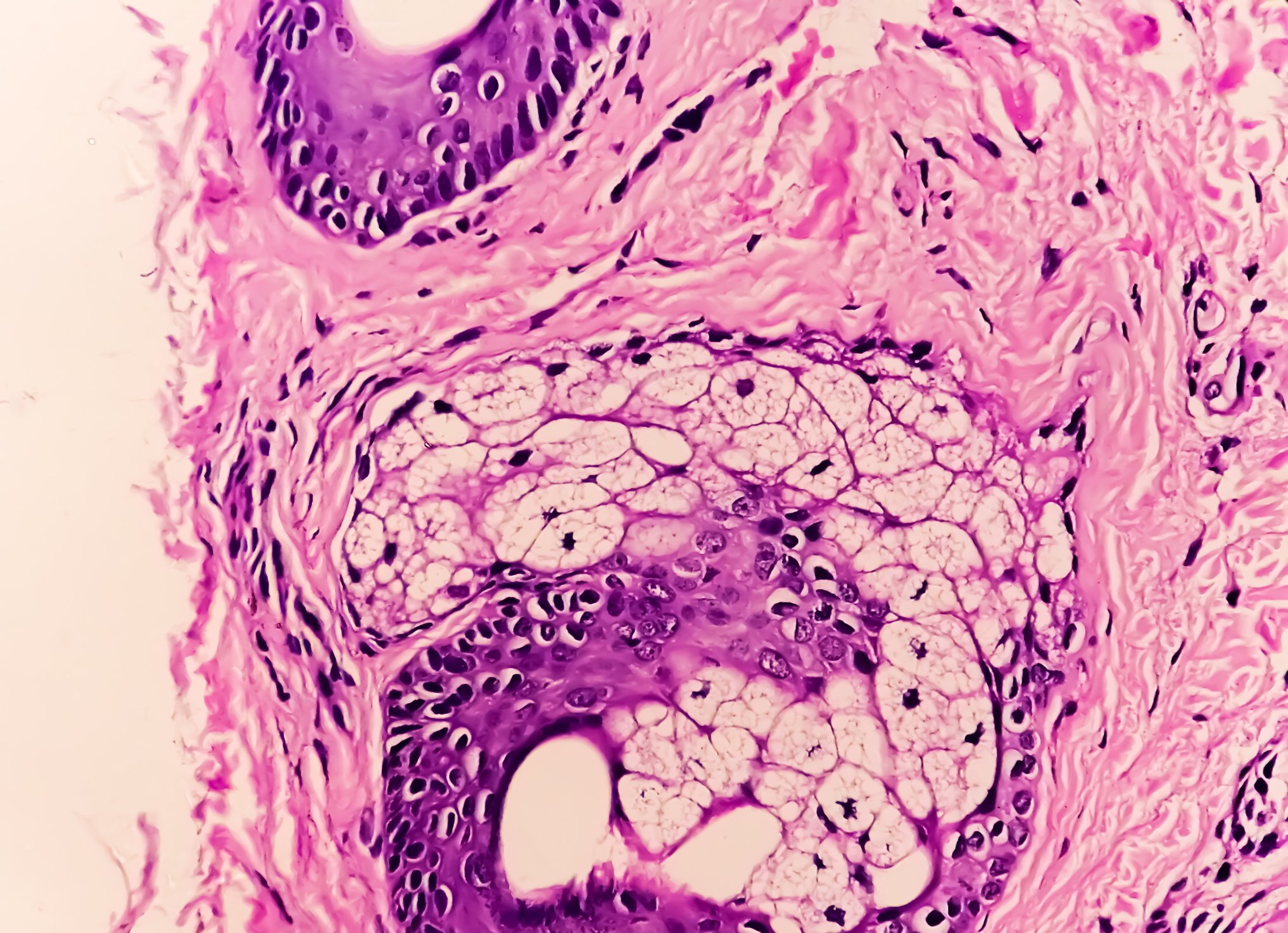Currently, it is not possible to predict which actinic keratoses (AK) will develop into squamous cell carcinoma (PEK) in the course of time. Study findings show that invasive PEK can also form from AK grade I. Therefore, AK should be treated as a matter of principle. Early therapy not only prevents the development of potentially serious skin tumors, but can also improve quality of life.
Data on incidence and prevalence of actinic keratosis (AK) vary, which has to do with methodological and geographic differences. Prof. Robert Hunger, MD, Skin Tumor Center, Senior Physician Dermatology, Inselspital Bern, referred to a study in which 48 dermatology practices in Austria were randomly asked to screen 100 patients over 30 years of age for the presence of AK [1]. In a total of 4449 patients, Eder et al. found an overall prevalence of AK of 31.0%, with a higher prevalence rate in men (39.2%) than in women (24.3%) and an age-correlated increase in both sexes. AK manifest in light-exposed, visible areas such as the face, scalp, and backs of the hands and have the potential to progress to invasive squamous cell carcinoma (PEC) [2].
Cumulative dose of UVB radiation at risk
The main risk factors for AK are UV damage, fair skin type and immunosuppression, the speaker explained. In addition to those already mentioned, HPV infections are also discussed as a risk factor for AK. The relationship between cumulative exposure to UV radiation and the occurrence of AK and PEK is considered empirically confirmed [3]. In particular, the cumulative dose of UVB radiation leads to DNA damage, mutations in the tumor suppressor gene “p53” and dysregulation of various signaling pathways. Professionals working outdoors, such as gardeners, farmers, and mountain guides, have a higher prevalence of AK. The most important preventive measure is to protect oneself from UV radiation through clothing and sunscreen.
An invasive PEK can also develop from AK grade I
About 70% of spinaliomas develop from AK. Olsen’s classification divides AK into three grades based on clinical-morphological criteria, although this has no prognostic significance, as recent studies have shown (review 1). “Spinaliomas can arise from early actinic keratoses,” explained Prof. Hunger [1]. Fernández-Figueras was the first to demonstrate that grade I AKs can also progress to invasive PEK [4]. While a general average of 6-16% of patients with AK develop invasive carcinomas (0.5% per year per AK), this rate is 40% in immunosuppressed patients. Organ transplant patients are more likely to die from skin tumors than from organ failure, the speaker said.
AK or invasive PEK? Dermatoscopy provides clarity
The diagnosis of actinic keratosis is primarily made by clinical examination and inspection. Typically, AK are reddish to brownish scaly rough foci, usually macular on chronically sun-exposed skin areas. In most cases, there is no itching. In clinically unclear findings, dermoscopy can be very helpful, the speaker said, especially to ensure that there is no infiltration (Fig. 1) [1]. In addition, confocal laser microscopy can be used, which is also frequently used for research purposes. “Actinic keratoses can be seen well on dermoscopy,” the speaker reported, adding that they are white dots on reddened skin, characterized by a ‘strawberry pattern’ [1]. In invasive carcinoma, on the other hand, one sees tumor mass surrounded by atypical vessels. “Dermoscopy is a very important tool for detecting AK and distinguishing whether something is already invasive or not,” Prof. Hunger summarized [1].
What are the advantages and disadvantages of each treatment option?
“There is no one best treatment or one right treatment,” said the speaker [1]. He said it is important to choose the treatment that is right for each patient and that it is a treatment option that people have confidence in. All of the above treatment options have been shown to be successful in some patients, and the results in comparative studies were not clearly in favor of one treatment option or the other. An important criterion is the patient’s preferences and how much compliance is possible and what side effects are accepted.
Cryotherapy is a very commonly used procedure. Cold application results in the formation of extra- and intracellular ice crystals and the cells are destroyed with subsequent blister and crust formation [5]. An advantage of cryotherapy is that it can be performed quickly; a disadvantage is that spotty hypopigmented scars may result [7]. In patients with multiple AKs and field cancerization, a combination of cryotherapy with topical treatment has been shown to be more efficient than monotherapy [6].
Photodynamic therapy (PDT) is also widely used. For PDT, 5-aminolevulinic acid (5-ALA), its ester methyl 5-aminolevulinate (MAL), or methylamino-oxo-pentanoate (MAOP) are applied to the area to be treated. These substances selectively accumulate in atypical keratinocytes and are converted into the endogenous photosensitizer protoporphyrin IX (PPIX). Photoactivation with light of appropriate wavelength generates reactive oxygen species and results in cell damage and selective destruction of tumor cells [8]. One disadvantage of this treatment option is that it is a relatively expensive and often very painful procedure.
Daylight PDT is a newer and less painful version of conventional PDT. After prior application of a chemical light protection filter, the photosensitizer (e.g. Metvix® or Ameluz® [12] is applied thinly to the face and capillitium and the patient is then exposed to daylight for two hours within 30 min [8]. As studies have shown, daylight PDT has been shown to be equivalent to the conventional method [9]. The outside temperature should be above 10 degrees, and there must be a minimum of sunlight. However, with today’s lighting devices (artificial light, LED), this procedure can also be performed indoors, the speaker said [1].
Imiquimod (e.g., Aldara® cream 5% or Zyclara® cream 37.5 mg/g [12] is a topical immunomodulator that binds to Toll-like receptor 7 and induces antiviral and antitumorigenic activity. Imiquimod must be self-administered by the patient over a treatment period of several months.
Diclofenac is an active ingredient from the group of non-steroidal anti-inflammatory drugs, which is used in the form of a three-percent gel for the local treatment of AK. Inhibition of the enzyme cyclooxygenase-2 (COX-2) inhibits cell proliferation, vascularization, and inflammation and promotes apoptosis of diseased cells. The gel is applied in the morning and evening for two to three months.
Tirbanibulin (Klisyri®) [12] is a new treatment option. This preparation, available as an ointment, has been approved in Switzerland since June 2022. Tirbanibulin is a cytotoxic and proapoptotic agent of the tubulin inhibitor group. The effects are due to direct binding to tubulin and inhibition of Src kinase. The fact that patients only need to apply this topical preparation once for five consecutive days is an advantage in terms of compliance. There is a slow healing with a significant reduction in AK. Tirbanibulin is approved for AK I and II.
Congress: Swiss Derma Day
Literature:
- «Aktinische Keratosen: Wann und wie behandeln», Prof. Dr. med. Robert Hunger, Swiss Derma Day 12.01.2023.
- Fernandez Figueras MT: From actinic keratosis to squamous cell carcinoma: pathophysiology revisited. Journal of the European Academy of Dermatology and Venereology 2017; 31(S2): 5–7.
- Schmitt J, et al.: Occupational ultraviolet light exposure increases the risk for the development of cutaneous squamous cell carcinoma: a systematic review and meta-analysis. British Journal of Dermatology 2011; 164(2): 291–307.
- Fernández-Figueras MT, et al.: Actinic keratosis with atypical basal cells (AK I) is the most common lesion associated with invasive squamous cell carcinoma of the skin. J Eur Acad Dermatol Venereol 2015; 29(5): 991–997.
- Vegter S, Tolley K: A network meta-analysis of the relative efficacy of treatments for actinic keratosis of the face or scalp in Europe. PLoS One 2014; 9(6): e96829.
- Heppt MV, et al.: Cryosurgery combined with topical interventions for actinic keratosis: a systematic review and meta-analysis. Br J Dermatol 2019; 180(4): 740–748.
- Borik-Heil L, Geusau A: Aktinische Keratosen. hautnah 2021; 20: 45–55.
- Leitlinienprogramm Onkologie, AWMF, S3-Leitlinie Aktinische Keratose und Plattenepithelkarzinom der Haut, Langversion 1.0, März 2020.
- Tampa M, Sarbu MI, Matei C: Photodynamic therapy: a hot topic in dermato-oncology. Oncol Lett 2019; 17(5): 4085–4093.
- Olsen EA, et al.: A double-blind, vehicle-controlled study evaluating masoprocol cream in the treatment of actinic keratoses on the head and neck. Journal of the American Academy of Dermatology 1991; 24(5): 738–743.
- Zielbauer S: Wenn der Patient die Wahl hat – Zufriedenheit bei der Behandlung aktinischer Keratosen und Ermittlung allgemeiner Therapiepräferenzen, 2021, https://openscience.ub.uni-mainz.de, (last accessed 01.03.2023)
- Drug Information, www.swissmedicinfo.ch,(last accessed 03/01/2023).
- Casari A, Chester J, Pellacani G: Actinic Keratosis and Non-Invasive Diagnostic Techniques: An Update. Biomedicines 2018, 6–8. www.mdpi.com/2227-9059/6/1/8.
DERMATOLOGIE PRAXIS 2023; 33(2): 18–19 (published 4/20-23, ahead of print).
InFo ONKOLOGIE & HÄMATOLOGIE 2023; 11(2): 30–31














